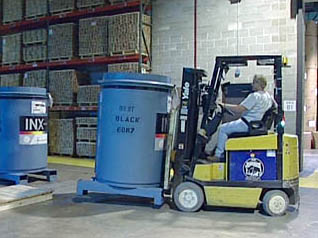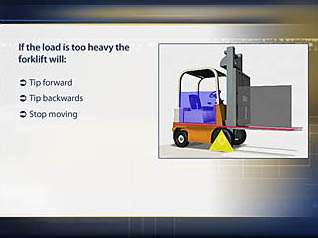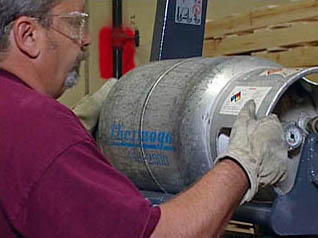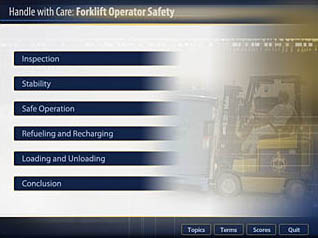Back to Course List
Forklift: Forklift Operator Safety: Handle with Care
- Product ID
- clmifshc
- Training Time ?
- 64 to 128 minutes
- Language(s)
- English,Spanish
- Video Format
- Standard Definition
- Required Plugins
- MasteryNet Player
- Lesson Interactions
- 14
- Quiz Questions
- 33
- Closed Captioning



Overview
Online OSHA Forklift Training
This OSHA Forklift Training discusses the equipment requirements to meet OSHA's powered industrial truck standard. OSHA Forklift Training thoroughly covers inspection, stability, safe operation of a forklift, and proper procedures when loading and unloading trucks and trailers
CERTIFICATE/ACCREDITATION
You will earn a certificate upon completion. This course qualifies for continuing education units.
YOU CAN HOST THIS COURSE ON YOUR SITE
You can take this course from our site or install it on your own corporate online training site.
OSHA REGULATION: OSHA 29 CFR 1910.178.
CERTIFICATE/ACCREDITATION
You will earn a certificate upon completion. This course qualifies for continuing education units.
YOU CAN HOST THIS COURSE ON YOUR SITE
You can take this course from our site or install it on your own corporate online training site.
OSHA REGULATION: OSHA 29 CFR 1910.178.
![]() This course is in the Advantage™ format, to read about Advantage™ features click here.
This course is in the Advantage™ format, to read about Advantage™ features click here.

- Install on any SCORM LMS
- Rich multimedia presentation with interactions and quiz
- Print certificate and wallet card
- You have 30 days to complete the course
Workplaces
Audience
For all forklift operators
Topics
The course presents the following topical areas:
-
Inspection
- Why inspect?
- The inspection process
- Inspecting propane tanks
- Inspecting batteries
-
Stability
- Tipping over
- Steering design
- Safe lifting capacity
- Load center
- The stability triangle
- Rated capacity
-
Safe Operation
- In case of tipping
- Lifting and moving the load
- Placing the load
- Traveling tips
-
Refueling and Recharging
- Propane tanks
- Personal protective equipment
- Battery charging
-
Loading and Unloading
- Dock hazards
- Trailer creep / Trailer walk
- Trailer restraint devices
- Communication techniques
- Preparing to load
- Oversized loads
- Offloading from the side
Intended Performance Outcomes
Upon successful completion of this course you will be better prepared to:
-
Properly inspect your forklift before use.
- List items to check during inspection.
- Identify specific items to check on a propane-powered forklift.
- Identify specific items to check on an electrically-powered forklift.
- Agree to report all unusual inspection issues before use.
-
Maintain stability while using the forklift.
- Identify lift truck tip-overs as one of the leading causes of operator injury and death.
- Differentiate driving a car and a forklift.
- Identify where the load on the forks is supported.
- Choose the proper method for testing your load.
- Select locations describing forklift capacity.
- Define load center.
- Explain the stability triangle.
- Agree that moving a load within the rated capacity does not guarantee stability.
- Identify situations that may cause the forklift to tip over.
-
Follow safe forklift operating procedures.
- Agree to always wear the seatbelt on a forklift.
- Explain the safest action to take if the forklift you are in is tipping.
- Identify the importance of remaining at or below load capacity.
- Explain the purpose of tipping the mast back when raising a load.
- Describe the action to take if the load obstructs your view.
- Identify the proper position of forks during travel.
- Choose proper following distance when traveling with a load.
- List rules for safe traveling.
- List steps to place a load after traveling.
-
Properly refuel or recharge your lift truck.
- Agree that refueling forklifts must be performed with the engine off.
- Select the two ways to refuel a propane tank on a lift truck.
- List protective equipment to wear when re-filling a fuel tank directly on to the lift truck.
- Recognize the need to have the charger off whenever connecting or disconnecting it from the battery.
-
Use the forklift to safely load and unload trucks and trailers.
- Identify the key to keeping the trailer securely in contact with the dock and dock plate.
- Recognize why air-ride trailers are more prone to move away from the dock during loading.
- List trailer restraining devices.
- Agree that signaling devices are acceptable forms of communication with the truck driver.
- Choose the proper way to prepare to load a truck.
- Explain how to safely move an oversized load onto a truck.
- Recall when side offloading is most hazardous.
© Mastery Technologies, Inc.




